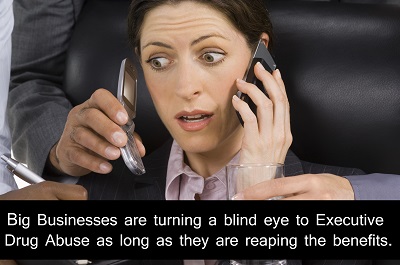30 May 2013
Do Some Businesses “Reward” Drug Abuse?
An article in the Australian Business Review Weekly tells the story of “Ruth,” a high finance worker in Sydney who left her job because she wanted to stop snorting cocaine. According to her story—which was told to an Australian rehabilitation worker—substance abuse was a 24-hour habit in her business, with executives constantly sneaking off to the bathroom for a pick-me-up.
Substance abuse specialist Josette Freeman argues that it isn’t unusual in that sort of industry, claiming that meetings over wine and dinner with clients often descend into cocaine-taking, and even that the high stress and production-focused businesses essentially reward drug abuse by ignoring the issue if it benefits them. In the United States, it’s estimated that business owners lose $100 billion per year as a result of drug abuse—and the facts about its impacts don’t paint the sort of picture these businesses might imagine.
“Benefits” for Businesses
According to the US Department of Health and Human Services, in 2009 77 percent of illegal drug users had either part time or full time jobs. Given the high rates of substance abuse amongst lawyers, it seems reasonable to assume that other high-level professions will also be affected.

If you place yourself into the shoes of a business-owner or other employer (with a limited capacity for foresight), you can see that there are several superficial benefits to a drug-using workforce. Most drugs don’t even have these, but stimulants like cocaine generally increase alertness, help people stay awake, improve mental performance and reduce appetite. If you think coldly and callously, as if you’re only interested in making a profit, these effects are big plus-points for stimulant use in the workplace. You feel like you’ll get an active, focused and dedicated work-force, willing to pull long hours and with an almost constantly positive morale.
According to Josette Freeman—whose work for drug rehabilitation group SMART has put her in contact with many white-collar addicts—“there are a lot of workplaces where they don’t care too much about the workers if they are producing.” This is at least echoed in the legal profession in the US, where the problem is often ignored and allowed to continue.
Risk Factors for Workplace Drug Abuse
There are numerous different elements which can make workplace substance abuse more likely. A particularly important one is stress (which will be addressed in detail later) but many other factors such as long or irregular shifts, tiredness, repetitive duties, isolation, ease of access to substances, lack of supervision and low job satisfaction are also notable risk factors. Some of these (such as stress, tiredness and long hours) would typically be more likely to affect higher-level workers, but others (such as repetitive duties and low job satisfaction) are a particular concern for blue-collar workers. Regardless of the specific risk factors, most jobs evidently carry some inherent risk of substance abuse.
The Importance of Stress
Stress is a key factor when it comes to any type of substance abuse, and this is particularly relevant for high-level professions that carry a lot of responsibility. The mechanism by which stress contributes to addictive behavior has also been studied, but it’s important to understand that stress only creates a susceptibility to addiction. It all depends on how individuals deal with the stresses of the workplace. Healthy coping mechanisms that don’t rely on substances enable most workers to manage stress without relying on substances as a mood-elevator. However, not everybody has these coping mechanisms.
For individuals with less healthy stress management strategies, a high-stress job in the financial or legal industries can easily lead them down the road to substance abuse. As mentioned in the previous section, this is particularly likely if there is easy access to substances in the workplace. This means that if there is a “culture” of drug abuse in the office, anybody exposed to high levels of stress is especially likely to get sucked in. To truly combat the issue of workplace substance abuse, employees have to be taught healthy coping mechanisms and about the long-term effects of drug abuse in the workplace.
The Truth of the Matter
As you may expect, workplace drug abuse—which may have an initial appeal to some employers and employees—ultimately reduces productivity, increases the number of absences, and makes regular changes in employer even more likely. Even stimulants, which initially seem like productivity-drugs, can cause panic, aggression, suicidal thoughts, paranoia, and hallucinations in chronic (long-term) users. On top of this, stimulant users ordinarily binge and then “crash” in a period of little activity characterized by depression, anxiety, and cravings.
Workplaces need to remain vigilant against drug abuse, and it’s advisable to have a policy in place for dealing with workplace substance abuse. In addition to educational programs to increase awareness, it’s important for employers to provide access to treatment and support. Businesses should also be clear about testing protocols and commit to disciplinary action where required. It’s a problem that spans all workplaces, and all businesses must take steps to protect against it.
Read more about The Dangers of Recreational Drug Use Here
The problem of inhalant abuse has surfaced again in a recent story from California, where nitrous oxide abuse is linked to the death of a college student. According to the Substance Abuse and Mental Health Services Administration (SAMHSA), over 1 million Americans abuse inhalants each year, and they’re keen to point out that the problem is far from confined to adolescents. In the wake of the incident, law-makers in California are looking at implementing new legislation and raising awareness to reduce the numbers of needless deaths from inhalant abuse. However, the strategy appears to be geared toward young people, when national research has shown that the majority of inhalant admissions are actually from adults.
The Recent Death
Nineteen-year-old Claremont McKenna College student Ali Mirza was found with nitrous oxide canisters, or “whippets,” in his dorm room when he died. He was rushed to Pomona Valley Hospital Medical Centre, after paramedics failed to revive him at the scene of the incident last month. He was pronounced dead at 2am on May 17th, and his funeral is scheduled for the June 15th. His family and friends will mourn his untimely passing, but the increased efforts of police officers and law officials to combat inhalant abuse may prove to have positive consequences for LA’s youth.
The Dangers of Inhalants
“Inhalants” is actually a fairly broad term to describe drugs that are “huffed” by users and many different substances could fall under the group. These include paint, marker pens, glue, air freshener, butane and substances like nitrous oxide. Despite the large number of substances used, most of them have similar effects to anesthetics and carry numerous potential risks. The most widespread (being a possibility with all inhalants) is sudden sniffing death syndrome, which basically results from a disturbance to the heart’s natural rhythm and is often fatal. Inhalants can also cause brain cell death, lung damage, short-term memory loss, and liver and kidney damage.
Nitrous oxide balloons (commonly known as “laughing gas”), in particular, pose a problem because the effect of a single “high” only lasts for five minutes or less. This means that users will generally repeat doses in a single evening of use, and this multiplies the potential for damage. When the user is “huffing,” he is depriving himself of oxygen, and repeated oxygen deprivation can lead to unconsciousness or—over time—brain damage.
The Response
The problem of inhalant abuse has been on the rise among California youths, according to Veronica De Alba (a deputy city attorney in LA), and this has led her to push for increased legislation to protect California adolescents. Police in the area are working on an ongoing 15-month investigation – entitled “Operation No Laughing Matter” – to curb the usage and availability of nitrous oxide. This has dramatically reduced the supply of the drug in the LA County area, but a continued effort is evidently required to prevent resurgence in usage down the line.
 Not Just Teens
Not Just Teens
Research from SAMHSA has shown that adults actually make up the majority of admissions to treatment facilities for inhalant abuse. The study showed that out of all admissions to treatment facilities for inhalant abuse, 54 percent were from people aged 18 or over in 2008. Admittedly, the majority of these admissions (52 percent) were from those in the 18 to 29 age group, but it still calls the adolescent focus of recent efforts into question.
While there is obviously a problem with inhalant abuse among teens, the problem is far from confined to them, and any public health-focused responses should take this into account. The sad truth is that inhalant abuse, like all drug abuse, may be commonly associated with troublesome youths, but it’s actually common in people from all walks of life. Some similar assumptions, which may be made about the race of inhalant abusers, were also addressed by the study and the results showed that the majority of the admissions were white males.
Broadening the Scope of Prevention and Education
Public awareness of the dangers of huffing will undoubtedly be improved by the recent story, but it’s important that you don’t mentally file it way as something that only really affects young people. The negative health impacts of huffing don’t discriminate based on age—they can affect any user—and research seems to show that adults are actually more likely to be heavy huffers. Broadening the scope of inhalant awareness campaigns to also appeal to adults initially seems like an unnecessary step, but statistics tell us that it’s just as vital as targeting teens and young adults.
As much as we are all dying for freedom and spontaneity, what we have to acknowledge is that ‘freedom’ isn’t really freedom at all. We want the option to be able to say ‘yes’ to our substance of choice whenever we want to—but what happens when we can’t say ‘no’? The ability to say ‘no’ is, too, a freedom and one that we lose when we pursue the false freedom of being able to engage in our addictive behaviors whenever we want to. There is, in fact, a trade-off. We cannot have our cake and eat it too. If you don’t have a problem with drinking, then you don’t need to worry about putting boundaries around your behavior. But if you are reading this, you are likely concerned that there may be a problem. By boundary what we actually mean is abstinence. It’s not the news you wanted to hear. You were hoping there was a way to drink and enjoy drinking like a normal person and then stop drinking when some internal trigger alerts you that you have enough. But isn’t this what you have been trying to do for months, years, or even decades?
 The 12-Step Program doesn’t set out to teach you how to live normally with alcohol, it teaches you how to live normally without it. This is the hard reality that we have to accept: we have tried to moderate our drinking and we have failed. We thought that having ‘control’ over when and how much we drank was what we wanted until we saw that we were no longer controlling alcohol—it was controlling us. It is time to give up the fight and accept that the only way to regain control of our lives is to get rid of alcohol entirely—to put a firm and unmovable fence between ourselves and drink.
The 12-Step Program doesn’t set out to teach you how to live normally with alcohol, it teaches you how to live normally without it. This is the hard reality that we have to accept: we have tried to moderate our drinking and we have failed. We thought that having ‘control’ over when and how much we drank was what we wanted until we saw that we were no longer controlling alcohol—it was controlling us. It is time to give up the fight and accept that the only way to regain control of our lives is to get rid of alcohol entirely—to put a firm and unmovable fence between ourselves and drink.
At first it seems controlling or overzealous. Are we just making too much of this whole thing? Plenty of people drink, we tell ourselves. Why do we need to be so serious about it?
So how does a boundary bring freedom? Because when you embrace sobriety, you receive your mind back. You have the power to say no. Alcohol is no longer your steamroller. And this is a freedom unlike the so-called freedom we think we had when we could drink ‘whenever we wanted.’ But there was a problem with that kind of freedom. We didn’t have the choice to not drink whenever we wanted. Alcohol was the boss. In sobriety we take our lives and our decision-making capacity out of alcohol’s hands and we reclaim it as our own.
We become free to make plans and keep them, to give our word and stick to it. We stop living in the shadows of broken promises and failed attempts and futility. When we get honest with alcohol, we get honest with ourselves and the rest of our lives and we become free.
Most of the principles of recovery contain a paradox and this concept is no different. But where has conventional wisdom or common sense ever gotten us? We have to reject the advice and the methods and the approaches that are not working for us and not serving our goal.
You have the right to be free. You have the right to be sober. You cannot imagine what that life will look like and certainly it is a little scary to think of. But what if, emotionally, you could be brought to a place of never actually needing a drink? What if life became manageable? What if you felt as good sober as you did the moment you took the first drink? Would you try it?
Watching for signs of relapse in loved ones. Read: Relapse Prevention: Signs of Relapse in Recovering Addicts
There is little argument that America is in the midst of an opioid epidemic, but health officials will argue about how to solve the problem.
Scientific articles published recently in the same journal represent ideas that conflict. The Annals of Internal Medicine, a publication established in 1927 by the American College of Physicians, published two articles on the subject of restriction prescription in hospital emergency departments. The issue revolves around the current guidelines for how much pain medication should be kept in the pharmaceutical areas of emergency departments. One side of the debate says that the current regulation of a three-day supply is not enough for the average emergency department. The other side of the debate says the limited supply will force doctors to make wiser choices in who gets what pain medicine.
Prescription Drug Abuse
New York City made headlines earlier this year when city officials announced that the most powerful and common painkillers on the market today would be restricted in the city’s 11 public hospitals. The move was in response to the abuse of painkillers that has gripped the city. These painkillers include Vicodin, OxyContin and Percocet. Methadone and Fentanyl are no longer distributed in the public hospitals. Those in favor of the restrictions note that there has been a rapid increase in opioid analgesic consequences and that restricting the medications in question will help doctors provide safer care for their patients who are experiencing issues with pain.
Many Americans now have an expectation that a visit to the emergency room will result in acquiring pain medication. Some emergency department personnel agree that something has to be done about that perception, which is bolstered by doctors that could perhaps be less willing to doll out the drugs to patients in pain. Non-narcotic medications are now beginning to find their way into emergency departments, as are pain meds that are engineered to be less addictive.
When someone is struggling with addiction, having a loving support group of individuals who are highly committed to his or her recovery and sobriety is important. Friends and family can help make rehab treatment successful and can also act as watchmen on the road to recovery. Surveys have shown that many of those seeking recovery from alcohol misuse experience at least one episode of relapse along the way. Drug abuse is similar. However, it is possible for watchmen to see road signs that warn a potential relapse is imminent.
Some signs are physical, some mental and others emotional, but they are all fairly accurate in predicting the direction the addict’s behavior will head. Alert loved ones will learn to read these cues and do what they can to steer the recovering loved one onto a better road.
If the person shows signs that just being around alcohol affects them, if he or she becomes anxious or irritable at gatherings where alcohol is served, a relapse may be in the offing. The recovering addict’s heart even may race if others nearby are consuming alcohol.
People who have been misusing alcohol or drugs have become accustomed to feeling numb or living in an emotional monotone. Living with the daily fluctuation of emotions can sometimes prove extremely trying. If the person expresses feelings of isolation, loneliness, or depression, these could trigger a relapse. Irritability and anger are also red flags that the person is finding it hard to manage mood shifts.

Relapse Prevention
Any small stress can be enough because the person is unpracticed in the art of problem-solving and evaluation or regulation of emotions. Testiness could be a red flag that self-soothing with alcohol or drugs is lurking.
While it is impossible to see into another person’s mind, listen for signs that the person is fantasizing or fondly remembering prior instances of substance use. Once the person embraces a positive mental image about using drugs or alcohol, he or she will often look for a way to re-connect with former companions or seek to drink or use drugs without others knowing.
Indulging in positive imagery feeds the cravings, yet the person feels conflicted and guilty about breaking sobriety promises. This self-inflicted stress means that relapse is likely. If you see your loved one reaching out to prior friends or becoming secretive, be aware that this could be a sign of relapse.
Loving friends and family can be on the watch for signs of relapse and they can even warn the person when they see signs of danger, but no one can control another person or prevent them from relapsing. Having an alert support network can make the chances of relapse diminish, but only one’s personal commitment to sobriety can safeguard him or her from the many ways that recovery can be temporarily derailed.
Find help with relapse prevention: Making Your Way in an Addiction Recovery Support Group
Have you ever noticed that no matter how old you are, no matter how far you’ve come in your career or how much life experience you’ve got under your belt, when your family gets together, you fall right back into old familiar patterns of relating to each other? Therapists would call these patterns of behavior “roles” – almost like the roles actors play. Every family does this to some extent, but in families that have been affected by addiction, the roles might seem like they are cast in concrete. Rigid and unchanging over decades, it seems like each child is born into their role and that’s it, forever.
Some important things to remember about these roles:
- They are not conscious choices. No parent decides, “I’m going to be a Chief Enabler” in my family. Kids don’t choose to become a Mascot or a Hero.
- The roles themselves aren’t “good” or “bad.” When growth and change is frowned upon, that is what’s bad for families. The stuckness and inability to grow beyond a role is what makes roles problematic in a family affected by addiction.
- These roles carry over into other areas of life, making intimate relationships problematic, or careers/professional relationships difficult to navigate.
- Treatment is helpful for becoming aware of these roles and how they are impacting your behavior. This is an area where therapy can be really useful and effective, and where insight can lead to making positive changes.
In prior articles, we’ve looked at the Chief Enabler and the Family Hero—two roles that are somewhat balanced in terms of having much that is positive about them and much that can be harmful or detrimental about them. These two roles are similar in that both Heroes and Enablers “over-function”—they tend to pick up the slack emotionally, financially, and in terms of physical chores. The drinker or substance abusers tend to not get to things (from dishes to bills to baseball games) because their focus is on using. The Hero and the Enabler both work hard—sometimes hard enough to make themselves physically ill—to maintain the appearance of a well-functioning family.
The Scapegoat
The Scapegoat is a very different type of role. This is the child who constantly gets in trouble, and constantly attracts negative attention. As a young child, this is the one who may be diagnosed with attention-deficit hyperactivity disorder (ADHD) or have “behavior problems” at school. Maybe a bully, or maybe just the class clown, this is the child who seems incapable of following rules or letting things be easy. For the Chief Enabler, this child is a thorn in his or her side.
Often as a teenager, the Scapegoat begins using drugs or alcohol. These children can have significant conflict with others in the family, and sibling issues between the Hero and the Scapegoat are common.
 These children are sometimes described as the “lightning rods” for the family, since they seem to attract negative consequences. They are the typical acting-out child: they act out all the anger, frustration, rage and fear that all of the family members may feel. When a parent drinks or uses drugs, that parent’s behavior can be unpredictable and frightening for children. Rules may change based upon whether the parent is drunk, hung over, or seeking a drink. Conversations that take place while the parent is under the influence might not be remembered the next day. Permission granted can be taken back, and moods can flip on a dime. The inconsistencies of the using parent’s behavior, and the covering up or “making nice” that the enabler does can also be confusing at best, and infuriating at worst. The Hero just works harder at pretending everything is fine and that the family is fine, despite all these emotions. The Scapegoat is the family member who insists the family get attention—he is the one who screams “something is wrong” and does so by being “wrong.”
These children are sometimes described as the “lightning rods” for the family, since they seem to attract negative consequences. They are the typical acting-out child: they act out all the anger, frustration, rage and fear that all of the family members may feel. When a parent drinks or uses drugs, that parent’s behavior can be unpredictable and frightening for children. Rules may change based upon whether the parent is drunk, hung over, or seeking a drink. Conversations that take place while the parent is under the influence might not be remembered the next day. Permission granted can be taken back, and moods can flip on a dime. The inconsistencies of the using parent’s behavior, and the covering up or “making nice” that the enabler does can also be confusing at best, and infuriating at worst. The Hero just works harder at pretending everything is fine and that the family is fine, despite all these emotions. The Scapegoat is the family member who insists the family get attention—he is the one who screams “something is wrong” and does so by being “wrong.”
When looked at this way, the Scapegoat is easier to understand. On the surface, the Scapegoats just seem like such screw-ups; it can be hard to feel compassion for them. They appear to be committed to making a mess of their lives, and they often appear to be uncaring about the impact their behavior has on others. However, looking at the bigger picture of the whole family, it is easier to understand those who take on this role as not only a scapegoat but also a sacrificial lamb: they sacrifice their own life, health, and happiness to get the problems in the family noticed. The messes they make are the “cry for help” that may get the real problem in the family noticed.
The big risk with the Scapegoat is that by the time he or she reaches adulthood, he or she may well have developed an addiction or legal problems, or have continued “fallout” from the messes that were made during the teenage years to such a significant degree that they have severe trouble getting started in adult life. The Scapegoat needs help more urgently and at a younger age than the Hero; not only is the risk of substance abuse higher for children in this role—the risk of suicide is higher as well.
Whenever groups of people get together—at work, in families, at the firehouse, on a sports team, or among the club members—individuals take on roles as part of interacting with each other. Someone might be the “class clown” in the room, always quick to make a joke or lighten up a situation; someone else might take on the role of “mom” and do the caretaking for the group. Roles are normal, inevitable, and in healthy situations, they help make for smooth functioning (or an easy target for gentle teasing!).
In families affected by addiction, or any family in which one or both of the parents are unable to fulfill their role as parent, there is a tendency for all family members to take on rigid and surprisingly predictable roles. In any group of children of addicts or alcoholics, ask about the roles in their families growing up and you will hear some very similar reports over and over again. In a dysfunctional family, the key difference regarding roles is that they are rigid: once you’re pegged as a Mascot or Hero, for example, you’re stuck. Behave in a way that is not in line with that role, and your entire family pressures you to get back in line. Placing a value on change, flexibility and authenticity (think of being authentic as embodying and expressing your individuality instead your role behaviors) are not typically part of dysfunctional family dynamics.
Several experts on addiction and family roles have named and described these typical roles. The names are a little different depending upon which author you’re reading: family systems therapist Virginia Satir used the terms placater, adjuster, distracter, blamer, and computer to label the different communication styles and roles family members take on. Claudia Black and Sharon Wegscheider Cruse built upon Satir’s work on communication styles and family roles, and used the names scapegoat, family mascot, hero/responsible one, and lost child to describe the different roles.
In an earlier article we discussed the role of the Chief Enabler, typically a role taken on by the addict or alcoholic’s partner. Here we’ll take a closer look at The Family Hero. This role could be taken on by any child in the family although birth order does seem to play a role with family heroes most commonly being the oldest child. The Family Hero is the child who lives the denial, devoting his or her life to proving that they are fine despite the “elephant in the living room.”
Characteristics of The Family Hero
The Family Hero is the perfect child. He or she takes on being perfect for the family as a way of proving that the addict or alcoholic’s drinking isn’t a problem. Look: I can get good grades, play a sport, and totally have my life together despite Mom or Dad’s drinking. The Family Hero crafts life to contradict the assumption by others outside the family that the drinking or drugging will affect the kids.
The children who take on the family hero role often do extremely well at whatever they take on, and are successful in the eyes of the world. They often become professionals; doctors or other healing professions are common. They often manage money well, and have very high standards for themselves and their own families.
They are often intolerant of their own emotions, and this is their Achilles heel. They need to be perfect, and they need their lives to be perfect to “undo” the imperfections they had to tolerate from early on. The problem is life is not perfect and uncontrollable things happen: accidents, being victimized, relationship problems, health issues…life tosses obstacles in our path constantly and the need to handle each one “perfectly” is a pressure family heroes place upon themselves.
Risks and Pitfalls
 This places the Family Hero at high risk for developing substance abuse problems themselves. Finding a way to cope with the tremendous internal pressures isn’t easy and all those unmet needs from childhood can crash into the adult pressures to “have it all together.” Substance abuse isn’t the only risk: eating disorders are also common among women who have filled this role in a dysfunctional family. The efforts to control the uncontrollable can easily be channeled into controlling eating and weight, and focusing on something tangible: appearance and/or weight can make the overwhelming pressures of making “everything” perfect feel more manageable. Children who have taken on the Family Hero role also seem prone to depression and anxiety, as they try so hard to make everything better than it was during their own childhood but inevitably feel as if they have failed, either due to their own dissatisfactions and old wounds, or due to the challenges and “bumps in the road” that life hands them.
This places the Family Hero at high risk for developing substance abuse problems themselves. Finding a way to cope with the tremendous internal pressures isn’t easy and all those unmet needs from childhood can crash into the adult pressures to “have it all together.” Substance abuse isn’t the only risk: eating disorders are also common among women who have filled this role in a dysfunctional family. The efforts to control the uncontrollable can easily be channeled into controlling eating and weight, and focusing on something tangible: appearance and/or weight can make the overwhelming pressures of making “everything” perfect feel more manageable. Children who have taken on the Family Hero role also seem prone to depression and anxiety, as they try so hard to make everything better than it was during their own childhood but inevitably feel as if they have failed, either due to their own dissatisfactions and old wounds, or due to the challenges and “bumps in the road” that life hands them.
How to Help
Often as an adult, the Family Hero feels like he or she needs to do everything, take on every responsibility, and be in charge of all of it. While this is understandable, since so much didn’t get done in a responsible or timely way during childhood, this inability to delegate or share responsibility, and the need to be in control of everything all the time is draining and destructive. You can see how a Family Hero could grow up to become a Chief Enabler as the roles in adulthood are rather similar.
Psychotherapy aimed at helping shed the Family Hero role can be effective. Learning to tolerate imperfection and the notion of “good enough” (as opposed to perfect) can be life changing for these people.
Part 3: Dysfunctional Family Roles: The Scapegoat Acts Out in Cry for Help
For parents struggling with addictions, trying to manage normal day-to-day family issues such as sibling rivalry and school stresses and pressures is compounded by a special complication, something specific to families dealing with addictions (or families in which one or both parents are unable to function in their parenting role on a regular basis). As hard as most parents try to protect their children from the negative impact of their drinking or drug use, the impact is experienced by all family members. One way this plays out is through rigid and dysfunctional family roles.
(or families in which one or both parents are unable to function in their parenting role on a regular basis). As hard as most parents try to protect their children from the negative impact of their drinking or drug use, the impact is experienced by all family members. One way this plays out is through rigid and dysfunctional family roles.
Before we continue, let me say something about family dysfunction. As a treatment provider for people with addictions and their families for many years, I saw how devastating addictions can be to lives young and old. What’s important to remember here is that despite having an addiction that often leads to very negative behaviors—including violence, abuse, neglect—and despite being labeled “dysfunctional” (we’ll get to that in a moment), these are families that also are bonded by love and loyalty. These are parents who love their children and want the best for them and children who love and defend their parents despite having suffered due to their behaviors.
Taking apart the word “dysfunctional,” the prefix ‘dys’ refers to pain. Dyspepsia is a stomachache; dysmenorrhea is the technical term for painful periods. Dysfunction in the family context means that a family is functioning in pain. Meals do get made, children attend school, play sports, parents work, but the context in which all this happens is emotionally painful. Sometimes my clients would get defensive about the term “dysfunctional,” telling me that it felt like blame to say their family “ didn’t function.” So I make a point of agreeing: there is functioning and often children from families impacted by addiction function very well in some ways; but it would also be unfair and inaccurate to fail to acknowledge the pain that occurs too.
Family Roles
In all families, affected by addiction or not, family members take on roles. Sometimes Mom takes on the role of the discipliner, sometimes Mom is the “banker” for the family. Dad might have been the “sports guy” or the social planner. Imagine a particular behavior—for example, climbing a tree or catching a frog—and most people would then be able to predict which family member would be most likely to engage in that behavior and which would be least likely. The kid who was “outdoorsy” or a girl who fit the “tomboy” role would be first in line. In healthy families, the roles arise from internal personality characteristics and are flexible—as a child grows, develops, and changes, so do the roles.
In families affected by addiction, certain specific roles seem to evolve. These roles are more rigid and predictable, and have been described by a few well-known writers in the field of addiction and family roles. The names change from writer to writer, but the basic roles are similar.
The Second in Command:
In families where addiction is impacting the dynamics, the alcoholics or addicts often have someone on “their side,” someone who takes on the task of keeping the family functioning by keeping the person who is using as functional as possible. This person calls in sick for the drinker, or makes excuses at “Meet the Teachers Night.” They find themselves lying to the kids, the neighbors, their friends and ultimately themselves. Family systems therapists refer to this role as the Chief Enabler, or Codependent. Sometimes in the literature on addiction and alcoholism, people refer to the codependent person as “addicted to the addict.” These people seem to need the relationship more than they seem to need their own health. Let’s take a closer look at this role.
This role is a tough one: the job includes handling all the chores and responsibilities the drinker is not doing. The Chief Enabler just takes over, managing, organizing, acting as the Executive Director, administrative assistant, communications director, and database manager, over-functioning in all these roles (the school principal called? Your boss called? A run-in with police? “I’ll handle it” is the typical Chief Enabler response). He or she is the glue that holds the family together, usually working long hours; often at a job earning money and then at home taking care of all the details that can get left unmanaged when an addict uses.
The purpose of this role is to prevent the family (including the drinker) from experiencing the negative consequences of addiction. Of course this is impossible, which makes this person feel hopeless and frustrated, but also very important, since there are small successes and triumphs (such as a little league game attended by the addict or alcoholic, or open house at the school) along the way. The Chief Enabler feels “stuck” and often very angry about their stuckness because they know how important they are to the “success” of the family (in fact, it often feels like “if I don’t do it, it won’t get done”).
People in this role often receive much praise and support from the community. People outside the family often admire the Chief Enabler, which is one of the few positives about being in this role—often others outside the family recognize how critical the Chief Enablers actions are to the health or even survival of the family—so you hear comments like, “Mary really holds that family together.” The other side of this coin is that they also feel alone and furious at being stuck with being the responsible one who has to take care of everything. The fact that these people often do an excellent job, partly because they’ve had so much practice, is their blessing and their curse and is the catch 22 they experience as “stuckness.”
Read Part 2: Dysfunctional Family Roles: The Family Hero Tries to Hide the Obvious Here.


